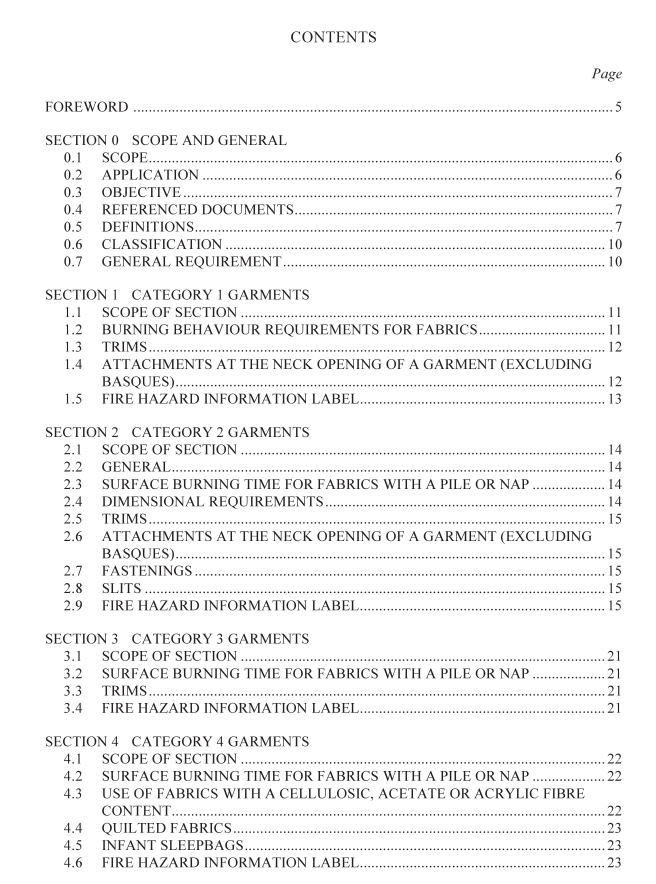AS NZS 1249 pdf download – Children’s nightwear and limited daywear having reduced fire hazard

AS NZS 1249 pdf download – Children’s nightwear and limited daywear having reduced fire hazard
Where required throughout the Standard, the combination of fabric and trim shall be tested by cutting the specimens so that the point of application of the flame (20 mm from the bottom of the specimen) is at the bottom edge of the trim. The test shall be in accordance with ISO 6941, using a 10 s ignition time.
1.3 TRIMS If the combination of fabric and trim conforms to the flame spread and surface burning time limits specified in Clause 1.2, no limitations apply to the use of trims. Other trims shall meet the following requirements:
(a) Edge trims on any edge of the garment other than the neck opening shall not have a free edge wider than 1.5 cm (see Figure 0.1).
(b) Trims other than edge trims with a free edge, shall have a sum total width of free edge of not more than 5 cm (see Figure 0.1).
(c) Trims shall not have loose portions or attachments wider than 1.5 cm, or extend more than 10 cm from their point of attachment to the garment, or beyond the hem or cuffs of the garment.
(d) Appliques, motifs and overlays shall be limited to the total amount of area in Appendix E, Table E1 for the range of garment sizes listed, and may be anywhere on the garment.
(e) Garments with a total area of appliques, motifs and overlays which exceeds the area specified in Appendix E, Table E1, shall be tested in accordance with Appendix F. The flame spread time for the fabric including trim, shall be not less than the fabric without trim.
(f) Inserts may be used above the waistline or above the elbow on the sleeve (see Appendix E, Table E2) without restriction.
(g) Inserts used below the waistline or below the elbow on the sleeve shall be limited to the amount of area in Table E1 for the range of garment sizes listed.
(h) There may be corded trim or piping in any material in any orientation provided it does not have free ends.
NOTES: 1 Attention is drawn to Clause 0.5.13 which defines trims and lists exclusions. Basques, which are defined in Clause 0.5.4 are excluded from trim requirements. Attachments at the neck opening of a garment are covered in Clause 1.4.
2 Some examples of calculating the allowable amount of trims for Category 1 garments are given in Appendix G and some examples of trims which exceed the allowable amount and are therefore unacceptable are given in Appendix H. 1.4 ATTACHMENTS AT THE NECK OPENING OF A GARMENT (EXCLUDING BASQUES) If the combination of garment fabric and attachments at the neck opening of the garment conform to the flame spread and surface burning time limits specified in Clause 1.2, no limitations are applied to their use.
Either the width or the length (as applicable) of any other attachment at the neck opening of the garment when measured from the neck seam shall not be more than the distance given in the following table:
1.5 FIRE HAZARD INFORMATION LABEL The label to appear on garments which comply with this Section shall be in accordance with Section 5 and shall be as shown in Table 5.1.
2.1 SCOPE OF SECTION
This Section covers requirements for garments made from more flammable fabric than those which comply with Section 1. Garments complying with this Section are styled to reduce fire hazard. The requirements of this Section are—
(a) burning behaviour requirements for fabrics with a pile or nap (see Clause 2.3);
(b) dimensional requirements for the garment (see Clause 2.4);
(c) requirements for trims (see Clause 2.5);
(d) requirements for attachments at the neck opening of the garment (see Clause 2.6);
(e) requirements for fastenings (see Clause 2.7); and
(f) requirements for slits (see Clause 2.8)
(g) the label to appear on the garment (see Clause 2.9).
NOTE: The garments covered in this Section include pyjamas, pyjama-style overgarments and sleep suits i.e. closer fitting garments, that because of their style are less likely to come into
contract with an ignition source. Some examples of styles of Category 2 garments are illustrated in Appendix I.









